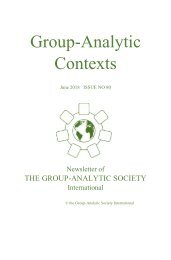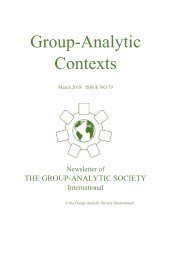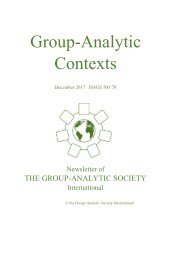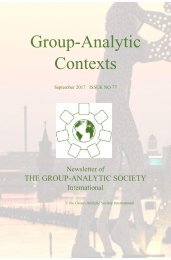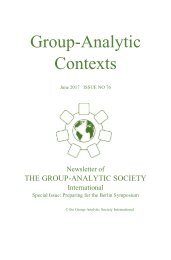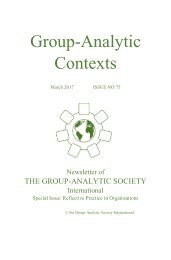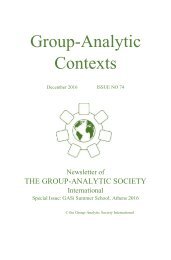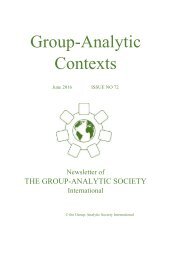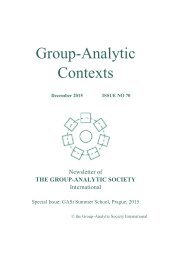Group-Analytic Contexts, Issue 81, September 2018
Newsletter of the Group Analytic Society International
Newsletter of the Group Analytic Society International
Create successful ePaper yourself
Turn your PDF publications into a flip-book with our unique Google optimized e-Paper software.
Newsletter – Autumn <strong>2018</strong> 23<br />
Brain plasticity ensures the ability of intervention (Chattarji, 2015;<br />
Kontis, 2017). Long-term potentiation is feasible via electrical neuron<br />
irritation resulting in the enforcement of synaptic transmission (Bliss<br />
and Lomo, 1973).<br />
The transgenerational transmission of trauma and<br />
possible interventions: is prevention possible?<br />
Preclinical experimental models indicate that transgenerational<br />
transmission of behavioral symptoms can be prevented. Negative as<br />
well as positive environmental factors impact on behavior through<br />
generations (Gapp, 2016).<br />
Scapegoating is a phenomenon observed in both social and<br />
therapeutic groups. The ‘passing stranger’ in anthropological<br />
literature was often seized and sacrificed, looked upon as a potential<br />
threat. A question is raised, whether the group, out of its needs, creates<br />
a scapegoat upon whom it can project all its accumulated guilty<br />
feelings - group with members who have inherent difficulties in<br />
expressing their aggression and guilt in the open forum. ‘The<br />
scapegoat may be selected in the first place on the elemental basis of<br />
being different’. The phenomenon is precipitated when the urgent<br />
need for the group to punish meets an urgent need in a particular<br />
member to be punished. (Foulkes, S.H. & Anthony, E.J., 1957).<br />
Through the stigma a distance and indifference for the other are<br />
created, a negative simulation, a ‘we’ versus ‘others’ distinction.<br />
Negative characteristics are attributed (e.g. he is dirty), whereas depersonalization<br />
and de-humanization gradually occur (Tzavaras N.,<br />
2017).<br />
When the suffering is unbearable, the idea of guilt seems to<br />
fill the empty place of the meaning. By the process of projective<br />
identification, guilt may be transmitted through generations and<br />
recycled (Klímová, 2007). Trans-generational, un-housed ghosts in<br />
the eyes of parents may look very ugly, and the child may rather flee<br />
from its own subjectivity. We often experience more than we can bear,<br />
so consequently dissociation occurs in order to prevent annihilation.<br />
<strong>Group</strong> flow can take different directions, either to vicious spirals or<br />
towards development. Development of our psycho-social identity is<br />
essential for us to take full responsibility for the matrix disrupted<br />
around us (Mojović, 2015).<br />
The re-libidinalization of self-representations may resolve<br />
the sense of helplessness and humiliation, tame aggression, end<br />
mourning, test reality and enhance the adaption to a new environment<br />
(Volkan, 2003). In-cohesion manifests in patterns of interaction,



